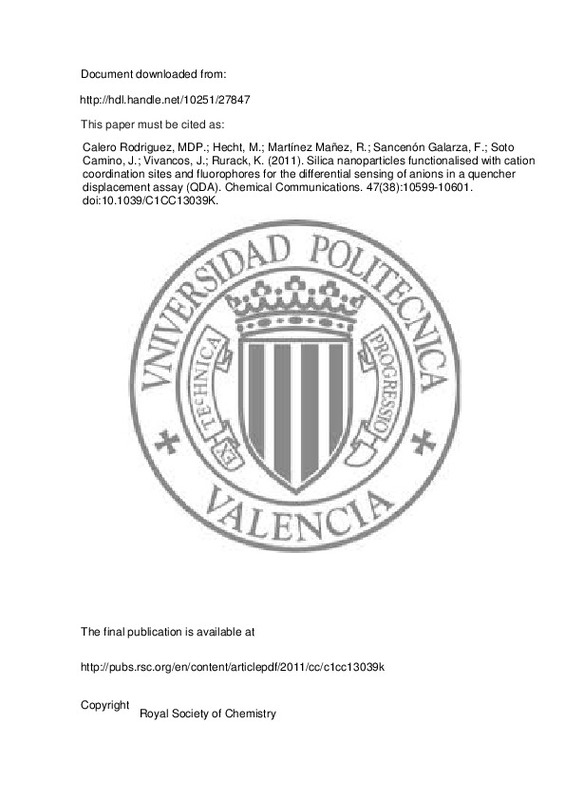Schmidtchen, F. P., & Berger, M. (1997). Artificial Organic Host Molecules for Anions. Chemical Reviews, 97(5), 1609-1646. doi:10.1021/cr9603845
Beer, P. D., & Gale, P. A. (2001). Anion Recognition and Sensing: The State of the Art and Future Perspectives. Angewandte Chemie International Edition, 40(3), 486-516. doi:10.1002/1521-3773(20010202)40:3<486::aid-anie486>3.0.co;2-p
Gunnlaugsson, T., Glynn, M., Tocci (née Hussey), G. M., Kruger, P. E., & Pfeffer, F. M. (2006). Anion recognition and sensing in organic and aqueous media using luminescent and colorimetric sensors. Coordination Chemistry Reviews, 250(23-24), 3094-3117. doi:10.1016/j.ccr.2006.08.017
[+]
Schmidtchen, F. P., & Berger, M. (1997). Artificial Organic Host Molecules for Anions. Chemical Reviews, 97(5), 1609-1646. doi:10.1021/cr9603845
Beer, P. D., & Gale, P. A. (2001). Anion Recognition and Sensing: The State of the Art and Future Perspectives. Angewandte Chemie International Edition, 40(3), 486-516. doi:10.1002/1521-3773(20010202)40:3<486::aid-anie486>3.0.co;2-p
Gunnlaugsson, T., Glynn, M., Tocci (née Hussey), G. M., Kruger, P. E., & Pfeffer, F. M. (2006). Anion recognition and sensing in organic and aqueous media using luminescent and colorimetric sensors. Coordination Chemistry Reviews, 250(23-24), 3094-3117. doi:10.1016/j.ccr.2006.08.017
Wiskur, S. L., Ait-Haddou, H., Lavigne, J. J., & Anslyn, E. V. (2001). Teaching Old Indicators New Tricks. Accounts of Chemical Research, 34(12), 963-972. doi:10.1021/ar9600796
Martínez-Máñez, R., & Sancenón, F. (2003). Fluorogenic and Chromogenic Chemosensors and Reagents for Anions. Chemical Reviews, 103(11), 4419-4476. doi:10.1021/cr010421e
Moragues, M. E., Martínez-Máñez, R., & Sancenón, F. (2011). Chromogenic and fluorogenic chemosensors and reagents for anions. A comprehensive review of the year 2009. Chemical Society Reviews, 40(5), 2593. doi:10.1039/c0cs00015a
Descalzo, A. B., Martínez-Máñez, R., Sancenón, F., Hoffmann, K., & Rurack, K. (2006). The Supramolecular Chemistry of Organic–Inorganic Hybrid Materials. Angewandte Chemie International Edition, 45(36), 5924-5948. doi:10.1002/anie.200600734
Martínez-Máñez, R., & Sancenón, F. (2006). Chemodosimeters and 3D inorganic functionalised hosts for the fluoro-chromogenic sensing of anions. Coordination Chemistry Reviews, 250(23-24), 3081-3093. doi:10.1016/j.ccr.2006.04.016
Shenhar, R., & Rotello, V. M. (2003). Nanoparticles: Scaffolds and Building Blocks. Accounts of Chemical Research, 36(7), 549-561. doi:10.1021/ar020083j
Beck, C., Härtl, W., & Hempelmann, R. (1999). Covalent Surface Functionalization and Self-Organization of Silica Nanoparticles. Angewandte Chemie International Edition, 38(9), 1297-1300. doi:10.1002/(sici)1521-3773(19990503)38:9<1297::aid-anie1297>3.0.co;2-9
Ludden, M. J. W., Reinhoudt, D. N., & Huskens, J. (2006). Molecular printboards: versatile platforms for the creation and positioning of supramolecular assemblies and materials. Chemical Society Reviews, 35(11), 1122. doi:10.1039/b600093m
Mendes, P. M. (2008). Stimuli-responsive surfaces for bio-applications. Chemical Society Reviews, 37(11), 2512. doi:10.1039/b714635n
Rampazzo, E., Brasola, E., Marcuz, S., Mancin, F., Tecilla, P., & Tonellato, U. (2005). Surface modification of silica nanoparticles: a new strategy for the realization of self-organized fluorescence chemosensors. Journal of Materials Chemistry, 15(27-28), 2687. doi:10.1039/b502052b
Crego-Calama, M., & Reinhoudt, D. N. (2001). New Materials for Metal Ion Sensing by Self-Assembled Monolayers on Glass. Advanced Materials, 13(15), 1171-1174. doi:10.1002/1521-4095(200108)13:15<1171::aid-adma1171>3.0.co;2-7
Calero, P., Aznar, E., Lloris, J. M., Marcos, M. D., Martínez-Máñez, R., Ros-Lis, J. V., … Sancenón, F. (2008). Chromogenic silica nanoparticles for the colorimetric sensing of long-chain carboxylates. Chemical Communications, (14), 1668. doi:10.1039/b718690h
Basabe-Desmonts, L., Beld, J., Zimmerman, R. S., Hernando, J., Mela, P., García Parajó, M. F., … Crego-Calama, M. (2004). A Simple Approach to Sensor Discovery and Fabrication on Self-Assembled Monolayers on Glass. Journal of the American Chemical Society, 126(23), 7293-7299. doi:10.1021/ja049901o
Ros-Lis, J. V., Marcos, M. D., Mártinez-Máñez, R., Rurack, K., & Soto, J. (2005). A Regenerative Chemodosimeter Based on Metal-Induced Dye Formation for the Highly Selective and Sensitive Optical Determination of Hg2+ Ions. Angewandte Chemie International Edition, 44(28), 4405-4407. doi:10.1002/anie.200500583
Ros-Lis, J. V., Casasús, R., Comes, M., Coll, C., Marcos, M. D., Martínez-Máñez, R., … Rurack, K. (2008). A Mesoporous 3D Hybrid Material with Dual Functionality for Hg2+Detection and Adsorption. Chemistry - A European Journal, 14(27), 8267-8278. doi:10.1002/chem.200800632
Rurack, K. (2001). Flipping the light switch ‘ON’ – the design of sensor molecules that show cation-induced fluorescence enhancement with heavy and transition metal ions. Spectrochimica Acta Part A: Molecular and Biomolecular Spectroscopy, 57(11), 2161-2195. doi:10.1016/s1386-1425(01)00492-9
García-Acosta, B., Albiach-Martí, X., García, E., Gil, L., Martínez-Máñez, R., Rurack, K., … Soto, J. (2004). Coordinative and electrostatic forces in action: from the design of differential chromogenic anion sensors to selective carboxylate recognition. Chem. Commun., (7), 774-775. doi:10.1039/b314997h
García-Acosta, B., Martínez-Máñez, R., Sancenón, F., Soto, J., Rurack, K., Spieles, M., … Gil, L. (2007). Ditopic N-Crowned 4-(p-Aminophenyl)-2,6-diphenylpyridines: Implications of Macrocycle Topology on the Spectroscopic Properties, Cation Complexation, and Differential Anion Responses. Inorganic Chemistry, 46(8), 3123-3135. doi:10.1021/ic062069z
Umali, A. P., & Anslyn, E. V. (2010). A general approach to differential sensing using synthetic molecular receptors. Current Opinion in Chemical Biology, 14(6), 685-692. doi:10.1016/j.cbpa.2010.07.022
[-]







![[Cerrado]](/themes/UPV/images/candado.png)


